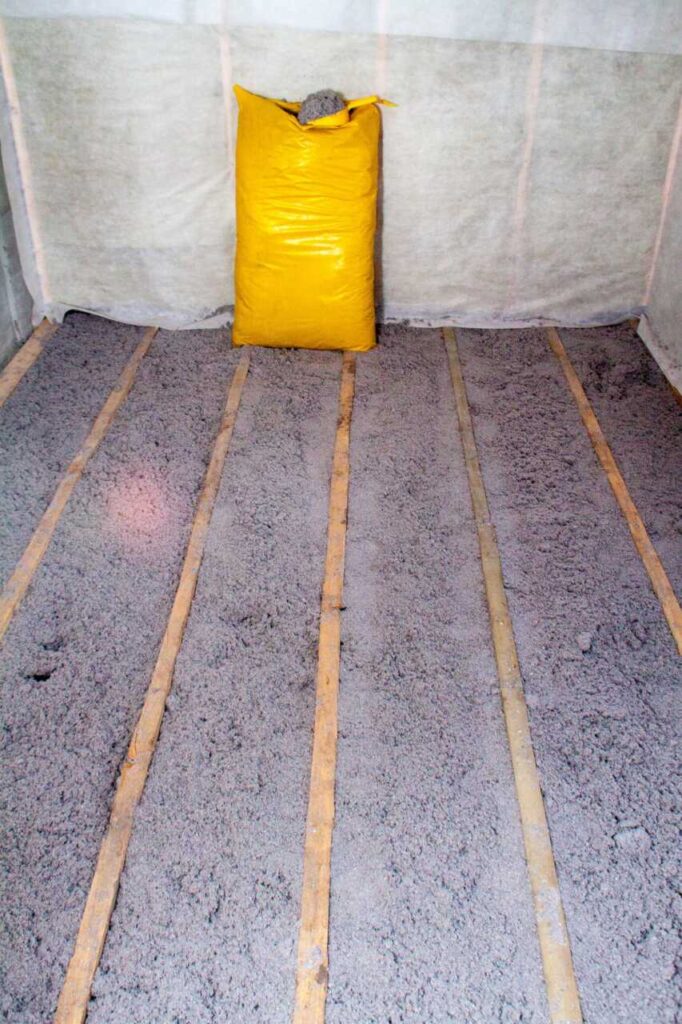
Contents
Isn’t it fascinating how the right insulation can dramatically impact your energy bills? When you consider blow-in insulation, several types stand out for their potential to enhance energy efficiency. Each option offers distinct advantages that could benefit your home. However, understanding the nuances of these materials and their installation processes is crucial for making an informed choice. So, which insulation type aligns best with your goals for energy savings?
Key Takeaways
- Fiberglass Blow-In Insulation offers high R-value, enhancing thermal performance and energy efficiency while being moisture resistant to prevent mold growth.
- Cellulose Blow-In Insulation is eco-friendly, made from recycled materials, and reduces energy consumption with superior thermal performance.
- Mineral Wool Blow-In Insulation provides excellent fire resistance, sound reduction, and moisture resistance, contributing to a stable indoor climate and energy savings.
- Higher R-values in insulation materials lead to better energy efficiency, making initial investments worthwhile for long-term savings on energy costs.
Fiberglass Blow-In Insulation
When considering insulation options for your home, fiberglass blow-in insulation stands out for its effectiveness and ease of installation. This type of insulation offers several fiberglass advantages, making it a popular choice among homeowners and contractors alike. Its lightweight nature allows for quick application, ensuring that you can enhance your home’s energy efficiency without extensive downtime.
One of the key fiberglass advantages is its excellent thermal performance. With a high R-value, fiberglass blow-in insulation provides superior resistance to heat flow, helping to maintain a comfortable indoor temperature year-round. Additionally, it’s non-combustible, which adds an extra layer of safety to your living environment.
Fiberglass applications extend beyond attics; it can be used in walls, ceilings, and floors. This versatility means you can effectively insulate various parts of your home, tailoring your approach to meet specific needs. By filling gaps and voids, fiberglass blow-in insulation can significantly reduce air leakage, further enhancing energy savings.
Moreover, fiberglass is resistant to moisture and mold growth, ensuring long-term durability and performance. This characteristic protects your home’s structural integrity and contributes to healthier indoor air quality.
Cellulose Blow-In Insulation
Cellulose blow-in insulation offers significant eco-friendly benefits, primarily due to its composition of recycled paper products.
Understanding the installation process is crucial, as it ensures you achieve optimal thermal performance while minimizing waste.
Let’s explore how this sustainable option can enhance your home’s energy efficiency.
Eco-Friendly Material Benefits
Among the various insulation options available, cellulose blow-in insulation stands out for its eco-friendly material benefits.
If you’re looking to make a sustainable choice for your home, cellulose offers numerous advantages that set it apart.
Sustainability Advantages: Made from recycled paper and other cellulose materials, it minimizes waste and promotes resource conservation.
Recycling Potential: The materials used can often be sourced from local recycling programs, reducing the carbon footprint associated with transportation.
Energy Efficiency: Cellulose provides superior thermal performance, helping to lower your energy consumption and costs.
Low Environmental Impact: Unlike some synthetic insulations, cellulose is biodegradable, making it a responsible choice for the planet.
Installation Process Overview
To achieve optimal energy efficiency in your home, understanding the installation process of cellulose blow-in insulation is essential. This technique involves several steps that ensure effective coverage and performance.
Start by preparing the space—seal any gaps and remove obstructions to create a clean working environment. Next, you’ll need to choose appropriate installation techniques, like using a blowing machine that evenly distributes the cellulose material.
When you’re ready to install, wear safety gear, including masks and goggles, to protect yourself from airborne particles. It’s crucial to follow safety precautions to prevent health risks during the process.
As you blow in the insulation, ensure you achieve the recommended density for maximum thermal performance. Keep an eye on the depth, aiming for a consistent fill that avoids voids or settling.
Once you’ve finished, inspect the area to confirm that the insulation is evenly distributed and covers all necessary surfaces.
Finally, properly clean up any excess material to maintain a safe and tidy workspace. By following these steps, you’ll enhance your home’s energy efficiency and create a comfortable living environment for you and your family.
Mineral Wool Blow-In Insulation
Mineral wool blow-in insulation, known for its excellent thermal performance and soundproofing qualities, is a highly effective option for enhancing energy efficiency in homes. If you’re considering insulation solutions, you’ll be pleased to discover the mineral wool benefits that make it a standout choice.
Here are some key properties of mineral wool that contribute to its effectiveness:
Fire Resistance: Mineral wool is non-combustible, providing an extra layer of safety for your home.
Moisture Resistance: It doesn’t absorb water, helping to prevent mold growth and maintain indoor air quality.
Sound Absorption: Its dense structure significantly reduces sound transmission, making your living space quieter.
Sustainability: Made from recycled materials, it’s an environmentally friendly option for insulation.
Regarding thermal performance, mineral wool properties ensure that your home stays warm in winter and cool in summer, ultimately leading to lower energy bills. The insulation works by trapping air within its fibers, creating a barrier against heat transfer.
This means you’ll enjoy a consistent indoor temperature, making your home more comfortable year-round. Additionally, the installation process is straightforward and can be completed quickly, minimizing disruption to your daily life.
With its combination of efficiency, safety, and sustainability, mineral wool blow-in insulation is a smart investment for anyone looking to improve their home’s energy performance. By choosing this insulation type, you’re enhancing comfort and contributing to a greener future for everyone.
Cost Comparison of Insulation Types
When considering insulation options, it’s essential to analyze both material costs and installation expenses.
Understanding how these factors impact your overall budget will help you make an informed choice.
Material Cost Analysis
Choosing the right insulation material can significantly impact both your initial investment and long-term energy savings. Understanding material pricing trends is essential as you develop effective insulation budget strategies.
Here’s a quick overview of factors influencing insulation costs:
Material Type: Different insulation materials come with varying price tags, affecting your overall budget.
R-Value: Higher R-values typically mean greater energy efficiency but can also increase upfront costs.
Market Trends: Fluctuations in raw material prices can affect what you pay for insulation.
Quantity Needed: The amount of insulation required for your space directly correlates with the total cost.
When you analyze these elements, you can make informed decisions without compromising your financial goals.
By carefully weighing these factors, you can align your insulation choices with your financial strategies and energy-saving goals.
Ultimately, investing time in understanding material costs will pay off by enhancing your home’s comfort and reducing energy bills.
Installation Expense Breakdown
Understanding the installation expenses associated with different insulation types is crucial for making cost-effective decisions. When evaluating your installation budget, you’ll need to consider both material costs and labor costs.
Blow-in insulation types, such as cellulose and fiberglass, each have varying installation expenses. For example, cellulose insulation typically has lower material costs but can incur higher labor costs due to the expertise required for proper installation.
Conversely, fiberglass insulation often falls in the mid-range for both materials and labor, making it a popular choice for homeowners conscious of expenses.
When planning your project, assess how these costs fit into your overall installation budget. Keep in mind that doing it yourself might save on labor costs but could lead to improper installation if you’re not experienced.
Installation Process Overview
Installing blow-in insulation requires careful preparation and execution to ensure optimal energy efficiency in your home. Understanding the installation process can make a significant difference in your project’s success. Here’s a concise overview of the essential preparation steps and installation techniques you’ll want to consider:
Assess the Area: Measure the space you plan to insulate, determining the amount of insulation needed.
Choose the Right Material: Select the blow-in insulation type that best suits your home’s needs, such as cellulose, fiberglass, or mineral wool.
Gather Equipment: Ensure you have the right tools, including a blow-in insulation machine, protective gear, and measuring tools.
Seal Air Leaks: Before blowing in insulation, seal any gaps or leaks in your attic or walls to maximize energy efficiency.
Once you’ve completed these preparation steps, you can move on to the actual installation. The most common installation technique involves using a blowing machine that aerates the insulation material.
This step requires you to fill the designated space evenly, ensuring proper density without overpacking. As you work, keep an eye on the coverage to avoid any voids or compressed areas.
Benefits of Blow-In Insulation
Completing the installation of blow-in insulation enhances your home’s comfort and brings significant energy-saving benefits. One of the primary advantages is its remarkable contribution to energy efficiency. By filling gaps and voids in your walls and attic, blow-in insulation creates a thermal barrier that helps maintain a stable indoor temperature. This means you’ll rely less on heating and cooling systems, ultimately reducing your energy bills.
Moreover, blow-in insulation excels in noise reduction. If you live in a bustling neighborhood or near a busy street, the soundproofing qualities of blow-in insulation can make a noticeable difference. The materials used, such as cellulose or fiberglass, absorb sound waves, preventing them from traveling through the walls and ceilings. This enhances your overall living experience, allowing for a quieter, more peaceful home environment.
Another benefit to consider is the eco-friendliness of many blow-in insulation materials. For instance, cellulose is often made from recycled paper, making it a sustainable choice. By selecting these renewable options, you’re improving your home’s insulation and contributing positively to the environment.
Finally, blow-in insulation can also improve your home’s resale value. Prospective buyers appreciate energy-efficient features, and having high-quality insulation can make your home more appealing in the competitive real estate market.
Review
In choosing the right blow-in insulation, you’re sealing your home and crafting a cozy sanctuary, much like the comfort of a well-worn blanket on a chilly night. Each type—fiberglass, cellulose, and mineral wool—offers unique advantages tailored to your needs. By investing wisely in insulation, you’re enhancing energy efficiency and paving the way for lower bills and a more comfortable living space. Remember, the wisest homeowner thinks ahead!
Recent Posts
Top 3 Efficiency Benefits of Blow-In Wall Insulation
When you’re considering ways to enhance your home’s efficiency, blow-in wall insulation might be one
7 Tips to Enhance Efficiency With Blow-In Insulation
To truly enhance efficiency with blow-in insulation, you need to focus on several key aspects
7 DIY Blow-In Insulation Techniques for Your Home
Did you know that homes lose their heat through poorly insulated areas? If you’re looking

